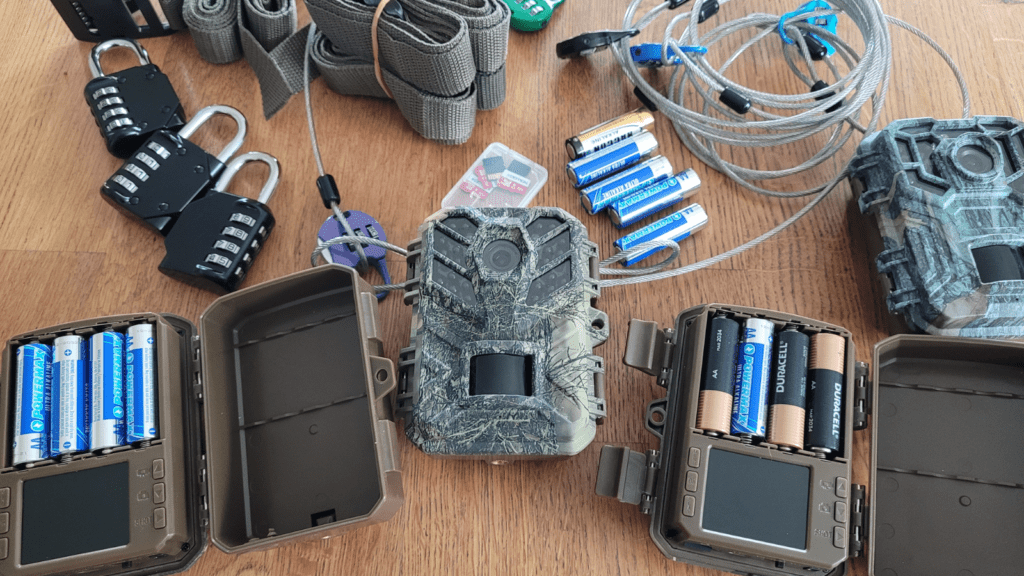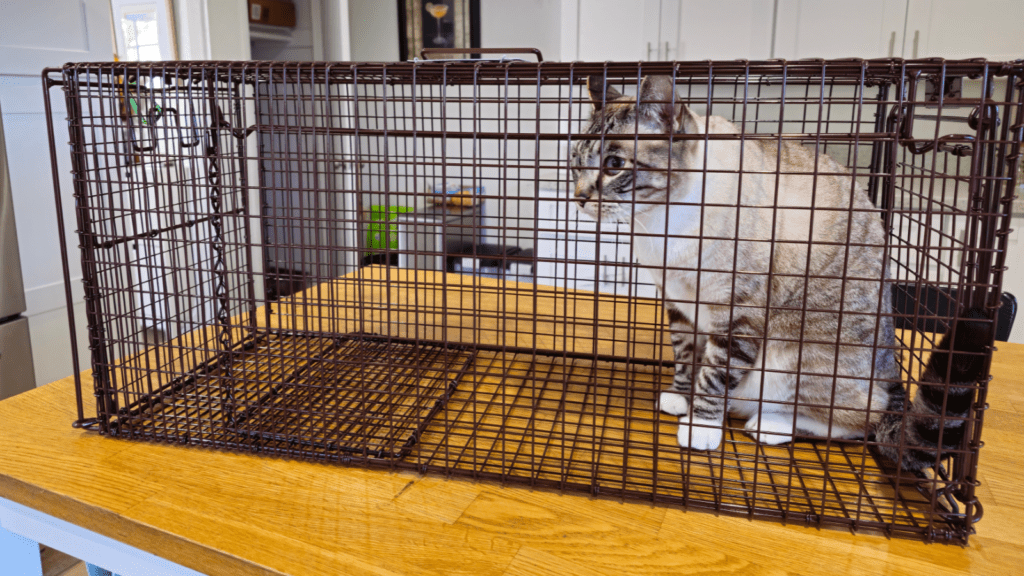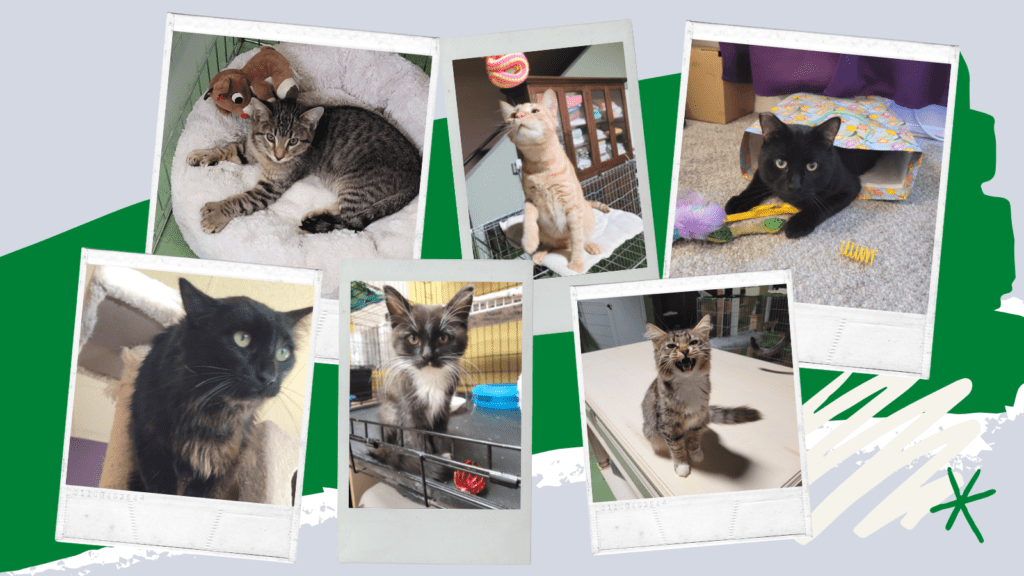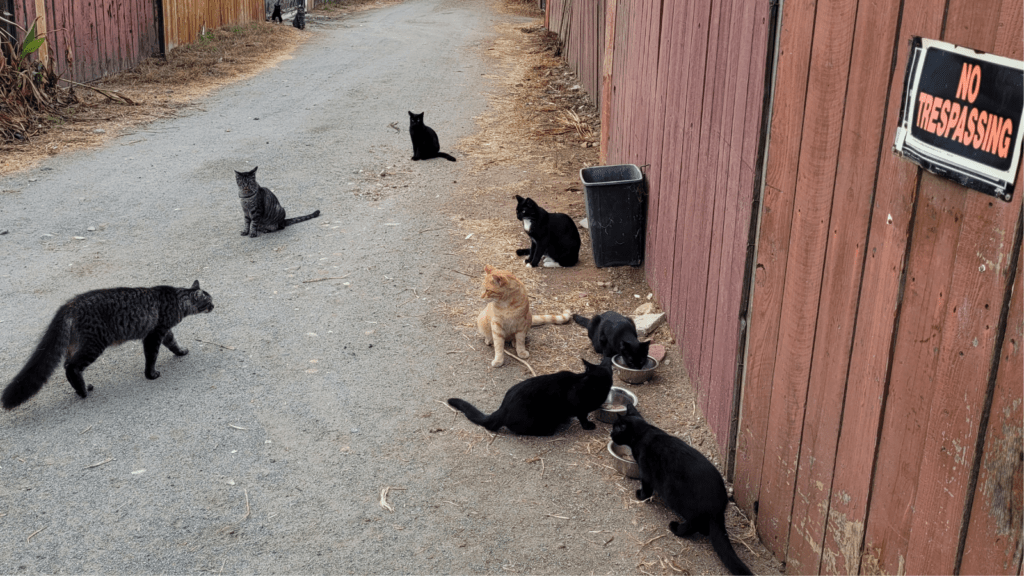
Drop Trap for Cats
As an experienced cat trapper and rescuer, I’ve had the opportunity to use a wide variety of feral cat traps, each with its own unique features, benefits, and challenges. Among these, the cat drop trap stands out as a particularly effective tool in specific scenarios, especially when dealing with wary or trap-shy cats. In this article, we’ll explore the workings of drop traps, examine the options available on the market, discuss their pros and cons, and compare them with other traps like gravity traps and spring-loaded traps. We’ll also cover when to use and when not to use a drop trap to ensure successful and humane cat rescue operations.
How Drop Traps Work
Drop traps function differently from traditional box traps, often referred to as standard or regular live traps. Instead of a door that closes to contain the cat, a drop trap uses gravity to enclose the cat within a large trap with an open-bottomed frame. The easy release sliding door feature enhances the efficiency of these traps, making it easier to transfer caught cats into other cages or boxes, such as transfer cages. The trap is typically set up with the frame propped up on one side, creating an open space for the cat to enter. The trapper uses a string or a simple pull mechanism to release the prop, allowing the frame to drop quickly and safely over the cat.
Once the cat is under the trap, the trapper can gently lift the frame slightly to slide in a transfer cage or box trap underneath, ensuring a smooth and safe transfer without causing stress or injury to the cat. This secure transfer method is particularly useful when working in a trapping space with limited room to maneuver. Ensuring the trap lands properly without any small gap is essential to prevent escape, especially when dealing with a female feral cat.
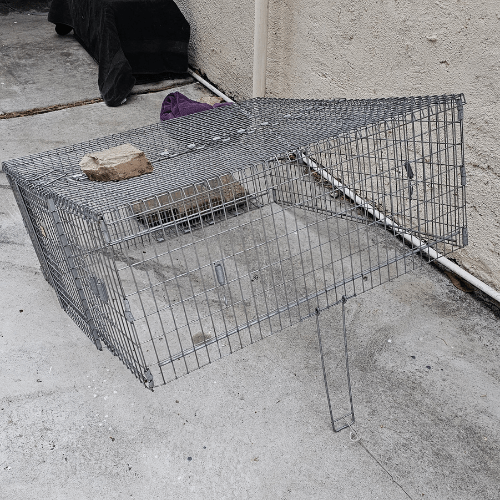
The Best Feral Cat Drop Traps
Choosing the right drop trap is essential for successful and humane cat trapping, especially when dealing with wary or trap-shy cats. Here are three top models and brands that are highly regarded in the cat rescue community:
Tomahawk Live Trap – Model DT1
Overview: The Tomahawk Model DT1, also known as the Tomahawk drop trap, is one of the most popular and reliable drop traps on the market. It features a large, sturdy frame made of galvanized steel and wire mesh, providing excellent durability and visibility. The trap is designed for easy setup and use, with a smooth release mechanism that ensures a quick and humane drop. This model is highly recommended for both professional and volunteer trappers.
Pros: Durable construction, easy to set up, and highly effective for trapping wary cats. The easy-release door lines work perfectly, ensuring the trap functions as intended every time. Tomahawk traps are known for their excellent quality, and they work wonderfully in various trapping scenarios, including those involving trap-shy cats.
Cons: The trap’s larger size may make it challenging to transport and store, especially in smaller vehicles. However, its effectiveness and quality make this trap a valuable tool for cat rescuers.
Neighborhood Cats Drop Trap
Overview: Developed by the Neighborhood Cats organization, this feral cat drop trap is specifically designed for Trap-Neuter-Return (TNR) programs. It’s lightweight and portable, constructed from a combination of metal and plastic mesh materials. The trap is easy to assemble and disassemble, making it convenient for fieldwork and easy storage. It also features a built-in transfer cage door for seamless and stress-free cat transfers, essential for securing one cat or when trapping multiple cats.
Pros: Lightweight, portable, and designed specifically for TNR programs, making it a favorite among community cat caretakers. The trap’s simple pull mechanism ensures ease of use, even in challenging conditions. This model has worked perfectly in various trapping scenarios and is praised for its convenience and effectiveness.
Cons: May not be as durable as heavier models, but it’s ideal for quick setups and on-the-go trapping. Some users may find the plastic mesh less durable than other materials used in standard traps, but it remains a convenient feral cat trap for many.
TruCatch – Model TD-30
Overview: The TruCatch Model TD-30 is a premium drop trap known for its robust construction and humane design. The trap is made from heavy-duty steel and features a smooth drop mechanism that minimizes noise and stress for the cat. The large opening of the trap allows for easy access, and it’s designed to accommodate cats of various sizes. The trap’s durability and quiet operation make it a top choice for serious trappers, especially when working in a trapping space where stealth is crucial.
Pros: Heavy-duty construction, quiet operation, and a large opening for easy trapping and transfers. This trap has worked perfectly for many users, and the weight flap ensures the trap closes securely, preventing escape. It’s also praised for its excellent quality and the way it works wonderfully in various trapping environments.
Cons: Heavier and bulkier than other models, which can be a drawback for trappers who need a more portable option. However, for those who prioritize durability and effectiveness, this trap is an excellent choice.
Pros and Cons of Drop Traps
Pros:
– Ideal for Wary Cats: Drop traps are particularly effective for trapping cats that have become trap-shy or are cautious of standard traps. The open design of the drop trap makes it less intimidating, increasing the likelihood of success.
– Humane and Stress-Free: Drop traps close quietly and gently, reducing stress on the cat. This is especially important when dealing with feral or semi-feral cats that are easily spooked.
– Versatility: Drop traps can be used to trap multiple cats at once, making them ideal for situations where you need to catch several cats in a short period of time. This makes them some of the most convenient feral cat traps available.
Cons:
– Bulkiness: Drop traps are typically larger and bulkier than other types of traps, making them more challenging to transport, set up, and store. This can be a drawback for trappers who need to move quickly or work in confined spaces.
– Requires Monitoring: Because drop traps require manual activation, they need to be closely monitored to ensure the trap is dropped at the right moment. This can be time-consuming, especially in situations where you are trying to trap multiple cats. Constructing your own drop trap can also be complex, involving skills in woodworking, selecting appropriate materials, and dealing with the challenges of creating a collapsible design for easy storage.
– Transfer Process: After trapping, the cat needs to be transferred to a box trap or carrier. This process can be tricky and requires experience to do safely and efficiently without stressing the cat.
Comparing Drop Traps with Gravity and Spring-Loaded Traps
Gravity Traps:
– Mechanism: Gravity traps use a simple trigger mechanism that causes the door to close due to gravity when the cat steps on the same plate. The mechanism is straightforward and reliable.
– Pros: Easier to set up and use, and generally safer for the trapped animal. They’re also effective in various weather conditions and can be used to trap animals like raccoons. Gravity traps can catch wary cats effectively when the right bait is used, and they often come with spring clips to secure the door.
– Cons: May not be as effective for trapping wary cats that avoid stepping on trigger plates. Also, these traps often require food as bait to lure the cat in, which might attract other animals as well.
Spring-Loaded Traps:
– Mechanism: Spring-loaded traps use a spring mechanism to snap the door shut quickly when triggered. This fast action reduces the chance of the cat escaping, even if they reach full speed while trying to flee.
– Pros: These traps are versatile, available in various sizes, and can be adjusted for sensitivity, making them effective for different types of cats, including kittens. They can also be attached securely to prevent the cat from escaping once caught.
– Cons: The noise and speed of the door snapping shut can be intimidating to some cats, making them less likely to enter the trap. This can be a disadvantage when dealing with trap-shy cats.
When to Use and Not Use a Drop Trap
When to Use a Drop Trap:
– For Trap-Shy Cats: Drop traps are ideal for cats that have become wary of traditional traps or have been trapped before. The open design is less intimidating and can increase your chances of success.
– For Trapping Multiple Cats: Drop traps are excellent for situations where you need to trap multiple cats at once, such as during a TNR operation in a large colony.
– In Environments Where Cats Are Easily Spooked: The quiet and gentle operation of a drop trap makes it suitable for environments where cats are easily frightened by noise or sudden movements. It’s also the most effective way to trap multiple cats without causing them to panic.
When Not to Use a Drop Trap:
– In Confined Spaces: The bulkiness of drop traps can make them difficult to use in tight or confined spaces. They require a flat, open area for proper setup, ideally with a stable ground to prevent any accidental movement.
– For Trapping Small Kittens: While drop traps can be effective for adult cats, they may not be as suitable for trapping very small kittens due to the size and weight of the frame. A conventional trap might be more appropriate for kittens.
– When You Need a Portable Solution: If you need to move quickly or work in a variety of locations, the size and weight of a drop trap can be a disadvantage. In such cases, a gravity or spring-loaded trap may be more practical. Additionally, ensure any trap you use is securely attached to prevent escape.
Conclusion
Drop traps are a powerful tool in the cat rescuer’s arsenal, particularly when dealing with wary or trap-shy cats. Their open design, quiet operation, and versatility make them an excellent choice for specific trapping scenarios. However, it’s essential to consider the specific needs of the cats you’re trying to trap and the environment in which you’re working. By understanding the pros and cons of drop traps and comparing them with other types of traps, you can make informed decisions that will lead to successful and humane cat rescue operations.
Check out our guides on the gravity cat trap and spring-loaded cat traps.
Whether you’re a seasoned trapper or new to the field, having a variety of traps, including those with spring clips, and knowing when to use each one will greatly enhance your effectiveness in helping our feline friends.
Lastly, remember to bring essential tools required for trapping, like animal handling gloves, bait to lure the cat, and contact information for a vet, to ensure a safe and successful operation. Ensuring that the trap is securely attached and that the cat doesn’t escape before you can bring it to the vet is crucial.

